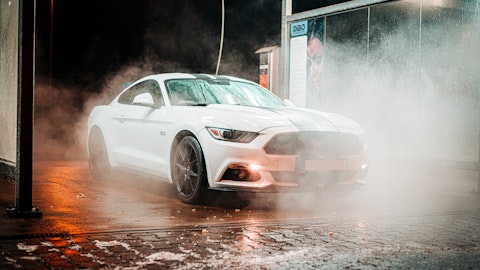But we don’t think anything fundamental has changed, and we think that we put a lot of pressure on ourselves over the last 18 months as we focused on getting more efficient. And just to use those same terms, the primary form that’s taken is we’ve shrunk our inventory by 50%, meaning that our selection of customers has gone down, and we’ve pulled back on marketing spend by 50%, and those things have fed back negatively. So, I think when it’s time to restart the engine, we expect that our offering will be received the same way that it was before. We expect that positive feedback will once again show up, and we expect that some of those things will lead to us selling millions of cars again in the future. I think we’ve spoken in the past about the distortions of the market that we’re in today, and I think that can sound a bit conceptual and kind of unclear.
But, I think, our statistic that I think is useful to think about as it relates to, how have things changed over the last 18 months, and is the last 18 months really the timeframe we should be looking at to extrapolate the long-term potential of Carvana, should we be looking at the earlier periods. Pre-pandemic, the average car that we sold was approximately a three-year-old car, and that car was for sale for approximately $19,500. More recently, the average car that we’ve sold has been 5.7 years old, and it’s been sold for $25,000. That’s a dramatically different situation, and I think there’s many, many reasons for that. One is, there was obviously a huge supply chain disruption. Most fundamental is it was a huge supply chain disruption that led to car prices going up relative to other goods.
It remains the case today that for consumers buying cars, they are spending approximately 50% more per month by the same car than they were pre-pandemic. They are spending on the order of 10% more on everything else they are buying. So cars have gotten relatively less affordable, and that of course has a very large impact. Our expectation would be that at some point in the not-too-distant future as supply chains get resolved, cars will probably have a similar cost relative to other goods as they had for a very long period of time before, and that’s a very big difference that we would expect. I think it’s also useful to note that one of the other reasons why the average car that we’re selling today is 5.7 years old versus 3 years old is because an entire portion of supply that we used to have ready access to, which was maybe two portions of supply, off-lease and off-rental, that we used to have ready access to, have largely evaporated because of the distortions that are driven by the price increases over the last year and a half, give or take.
And the reason for that is that all the cars that are coming back off-lease today, those were leases that roughly, if we assume the average lease is 36 months, they were leases that were written three years ago. Three years ago, car prices were in a completely different spot, and so the expected value of cars being returned was in a completely different spot. And as those cars are being returned today, every dealer where those cars are landing is very smartly picking those cars up and benefiting handsomely to the tune of thousands of dollars per unit from all those cars that are showing up on their lot. And so basically, off-lease cars are just not flowing through auction today. And because the OEMs have been constrained, there are very few rental cars that have been flowing through auction today.
So those are big, big distortions that lead to a meaningful change in the portion of the market that we are accessing, but I don’t think that there are strong arguments that we should expect that to persist over any meaningful period of time. And I think there have already been early signs of some normalization. We’ve seen depreciation pick up a little bit more recently. We would love to see that continue. I think there is nothing that will lead to the normalization of the market more quickly than car prices coming back into line with where they historically were or even close to where they historically were. And so I think we very much look forward to that. But as those distortions unwind, I think the more likely scenario, or at least our belief, and everyone can make up their own mind, is that we’re back in the world that we were for eight years before.
And in that world, we have in offering customers love. We have a highly differentiated model. We have a ton of infrastructure that we can grow into. We have a business that gets better as it gets bigger. We have a team that is hustling fast and has always hustled fast and has changed the direction of that hustle over the last 18 months, but is ready to change it back, and we’re going to go hit our goals. So I think when we look forward, we don’t know exactly what the growth rates are going to be. We’re not ready yet to provide that. I think it’s going to depend on all sorts of factors, macro factors, industry factors, our own execution. But we do expect it to be considerable, and our expectations for the future are absolutely unchanged versus what they were before.
Chris Bottiglieri: Got you. Very clever. Thank you, Ernie.
Ernie Garcia: Thank you.
Operator: The next question comes from Michael Montani with Evercore ISI. Please go ahead.
Michael Montani : Hey, good evening. Thanks for taking the question. Just wanted to ask if I could, if you could discuss a little bit what you saw in terms of the wholesale market, both with respect to volumes, but then also I think some of the relatively wide spreads between wholesale and retail that you referenced and if there’s any update into October on that front?





